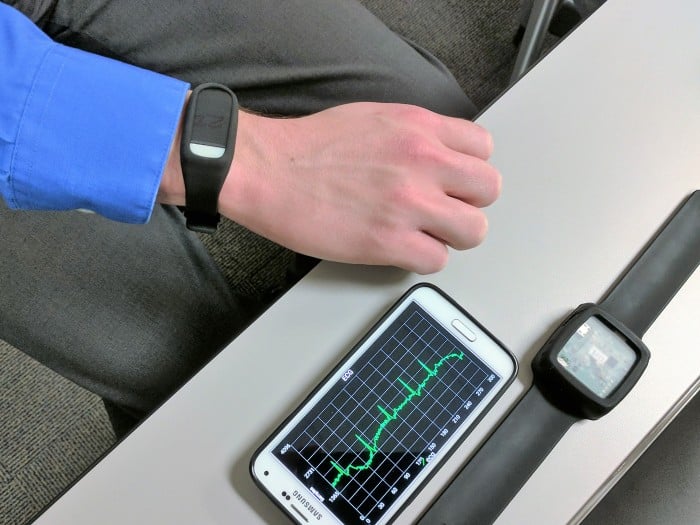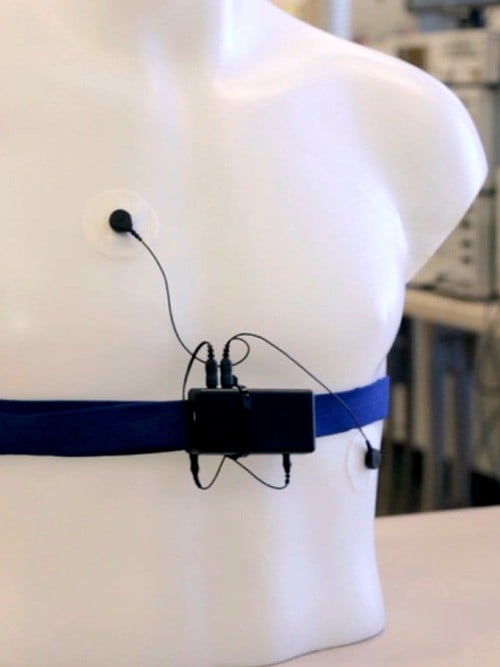These Wearables Detect Health Issues Before They Happen

Future generations of Apple Watches, Fitbits, or Android Wear gadgets may be able to detect and mitigate health problems rather than simply relay health data, thanks to a federally funded project that is applying big-data tools to mobile sensors.
The project, called MD2K, won $10.8 million from the National Institutes of Health to develop hardware and software that compiles and analyzes health data generated by wearable sensors. MD2K’s ultimate goal is to use these sensors and data to anticipate and prevent “adverse health events,” such as addiction relapse. Though the project is aimed at researchers and clinicians, its tools are freely available, so these innovations could turn up in consumer wearables.
Commercial wearable devices aren’t suitable for research because they only gather a few types of health data about a user, such as number of steps taken and heart rate, and they typically display specific results rather than raw sensor data. In addition, their batteries can’t support a full day’s worth of high-frequency data collection and they don’t quantify the degree of uncertainty associated with their data.
To address these shortcomings, the MD2K team, which spans 12 different universities, produced a set of gadgets capable of collecting a variety of raw, reliable sensor data for 24 hours per charge. MotionSense is a smart watch that deciphers users’ arm movements through sensors and can track heart rate variability. EasySense is a micro-radar sensor worn near the chest to measure heart activity and lung fluid volume. MD2K researchers are also using AutoSense—invented before MD2K was established—a chest-band that gleans electrocardiogram (ECG) and respiration data. All three devices stream data via Wi-Fi to Android phones where an MD2K-built software platform processes the information and translates it into digital biomarkers about the wearer’s health status and risk factors.
Since MD2K’s work is open-source, manufacturers such as Apple, Garmin, and Samsung could use the project’s designs to build similar sensors and apps for their own wearable devices. For example, MD2K’s MotionSense “HRV” wristband has three types of LED sensors (red, infra-red, and green) embedded in its underside, while most fitness trackers and commercial smart watches, such as the Apple Watch, have only green LEDs. Because the MD2K gadget can calculate differences in the ways a user’s blood absorbs its various sensor lights, it is able to compute heart rate variability, i.e., variations in the time interval between heartbeats, instead of just measuring a user’s heart rate in terms of beats per minute, as most of today’s wearables do.

This heart-rate variability data, along with respiratory signals, can help gauge a person’s stress levels. Emre Ertin, an Ohio State University professor who developed MD2K’s wearable gadgets, says manufacturers could easily implement this “stress biomarker” in their devices. Some commercial wearables, such as the Spire “mindfulness and activity tracker” and Fitbit’s more expensive models, claim to detect stress (through tense breathing), but other popular wearables, including the Apple Watch, Garmin’s “vivo” series, and Samsung’s GearFit2, do not.
Academics at Northwestern and Ohio State universities are already using the MD2K wearables to understand when and why abstinent smokers relapse and to assess congestion in congestive heart failure patients so they can avoid hospitalization. The smoking cessation study pulls information from multiple sources, including the MotionSense wristband’s accelerometer and gyrometer, which evaluate the wearer’s wrist position and movement to identify smoking gestures; the gadget’s heart-rate variability sensors, which assess stress; and the GPS in the user’s smartphone, which yields clues about location. MD2K researchers then examine the data to see which environments and behaviors trigger smoking lapses. Eventually, they will leverage that knowledge to launch “just-in-time” interventions in the form of pop-up messages or surveys on the participant’s smartphone.
It seems inevitable that these advances will trickle down to consumer wearables, but some experts advise caution. “If you take one thousand people who are trying to quit smoking and add an intervention that is digital and mobile, you’ll get some uptake because these people were previously using nothing [to guard against relapse],” says Joseph Kvedar, who heads the Boston-based Partners HealthCare SystemCenter for Connected Health and teaches at Harvard Medical School. “But I don’t think anyone really knows how effective any of these things are, long term.”
Keep Reading
Most Popular
Large language models can do jaw-dropping things. But nobody knows exactly why.
And that's a problem. Figuring it out is one of the biggest scientific puzzles of our time and a crucial step towards controlling more powerful future models.
How scientists traced a mysterious covid case back to six toilets
When wastewater surveillance turns into a hunt for a single infected individual, the ethics get tricky.
The problem with plug-in hybrids? Their drivers.
Plug-in hybrids are often sold as a transition to EVs, but new data from Europe shows we’re still underestimating the emissions they produce.
Stay connected
Get the latest updates from
MIT Technology Review
Discover special offers, top stories, upcoming events, and more.